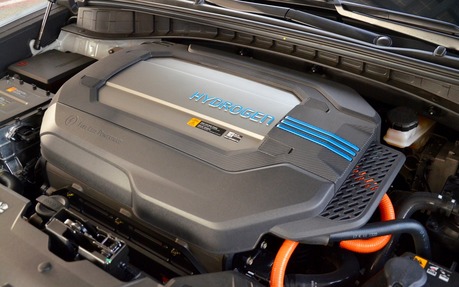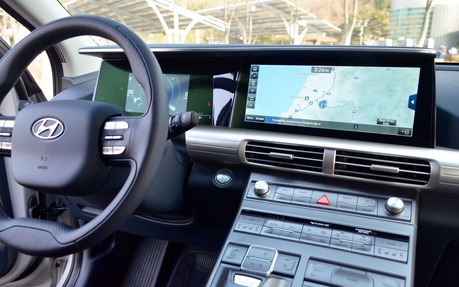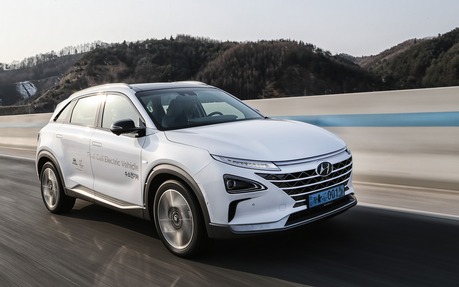2019 Hyundai Nexo: The New Hydrogen-powered SUV is Coming to Canada
The Nexo dashes at 140 km/h on the highway that links Seoul to PyeongChang. Inside, everything is calm, with slight wind noise breaking the silence from time to time. The Nexo’s handling is similar to an electric vehicle in every way, despite the fact that it produces its own electricity by way of a hydrogen-powered fuel cell.
Driving from Seoul to PyeongChang, the Winter Olympics serve as a backdrop for Hyundai, which chose this prestigious event to highlight the imminent launch of the brand-new Nexo SUV.
- Also: 2018 Hyundai Elantra GT: Priced to Please
- Also: Hyundai Le Fil Rouge Concept Unveiled in Geneva
A new, more efficient fuel cell
The new fuel cell, developed by Hyundai for the Nexo, converts 60% of the hydrogen consumed into usable energy, making it more efficient than a conventional gas-powered combustion engine, which converts only 25%, and loses 75% of the energy in heat. The power generated by the Nexo drivetrain is equivalent to 151 horsepower and its maximum torque is rated at 291 lb.-ft., helping the vehicle clock in at 9.7 seconds in the 0-100 km/h sprint.
An on-board lithium-ion battery ensures that power is delivered in linear fashion. This battery provides the power required for initial acceleration, acting as a buffer, since the fuel cell reacts to the command with a one-second delay. When starting the vehicle, the fuel cell requires a certain amount of time to deliver power. It can take up to 30 seconds when the outside temperature is -30°C.

With the exception of the delay before you can head off after starting the vehicle, the Nexo drives like a conventional vehicle. According to Hyundai, the new fuel cell should have a lifecycle of 5000 hours, which is equivalent to about 10 years of use for the average driver. It’s also a significant increase compared to the Tucson Fuel Cell EV’s battery, which has a five-year lifecycle.
Water vapour exhaust
The 2019 Nexo will be sold in limited quantities starting next month in South Korea before being sent to other target markets. Hyundai developed a brand-new architecture for this front-wheel-drive SUV, confirming Hyundai’s image as a “green” brand, as the only direct emission from this SUV is water vapour.
Filling up with hydrogen takes five minutes using a special pump that can deliver 700 bars of pressure. The Nexo’s operating range is 600 kilometres. The only disadvantage—for the Nexo as for theToyota Mirai and the other vehicles that use this technology—remains the embryonic hydrogen distribution network, here as elsewhere in the world. There is only a handful of hydrogen charging stations in Canada at the moment.
A modern look and a meticulous—but generic—design
The Nexo’s design is meticulous, but generic. The new SUV features a very unique front grille and retractable door handles like those found on the Range Rover Velar. Inside, the Nexo doesn’t look like any other SUV from the Korean brand—the cabin design is a mix of high-tech and retro styling.
The colour touchscreens located on the dashboard mimic what Mercedes offers in the S- and E-Class, but the design of the numerous buttons situated on the floating central console are a throwback to Toyotas from 10 years ago. It runs counter to the Nexo’s groundbreaking purpose and cutting-edge drivetrain. This console is also needlessly wide, which makes you feel a bit cramped. It does not have a conventional shifter, instead opting for push-button commands.
There is plenty of space in the cabin and cargo hold, which is 461 litres. Since the Nexo was built using architecture specifically conceived for a fuel cell vehicle means that the engineers were able to position all the necessary components, including three hydrogen tanks with a total capacity of 156 litres, without encroaching on interior space.

Electronic driving aids
Hyundai has developed prototypes of the Nexo that integrate everything you need for level 4 autonomous driving. We rode in one of these vehicles on the public roads near the PyeongChang Olympic Stadium. Once the system was engaged, the Nexo drove itself, negotiating turns, making mandatory stops and even driving in a roundabout with other vehicles. All this without the driver ever having to touch the steering wheel or pedals!
This technically advanced device will not be offered on the upcoming Nexo, though it will still be equipped with adaptive cruise control, a system that keeps you in the centre of the lane, but requires the driver to handle the wheel at least every 10 seconds, and an automated parking system.
25 units for Canada
The Hyundai Nexo will be available in Canada starting from the fourth quarter of 2018 as a 2019 model. The Korean brand foresees selling 25 units (of a total run of 3000) of the Nexo in Canada. The brass at Hyundai Canada has not yet specified the price or the terms and conditions of acquiring or long-term leasing the Nexo for our market. We’ll be keeping an eye on this story!
